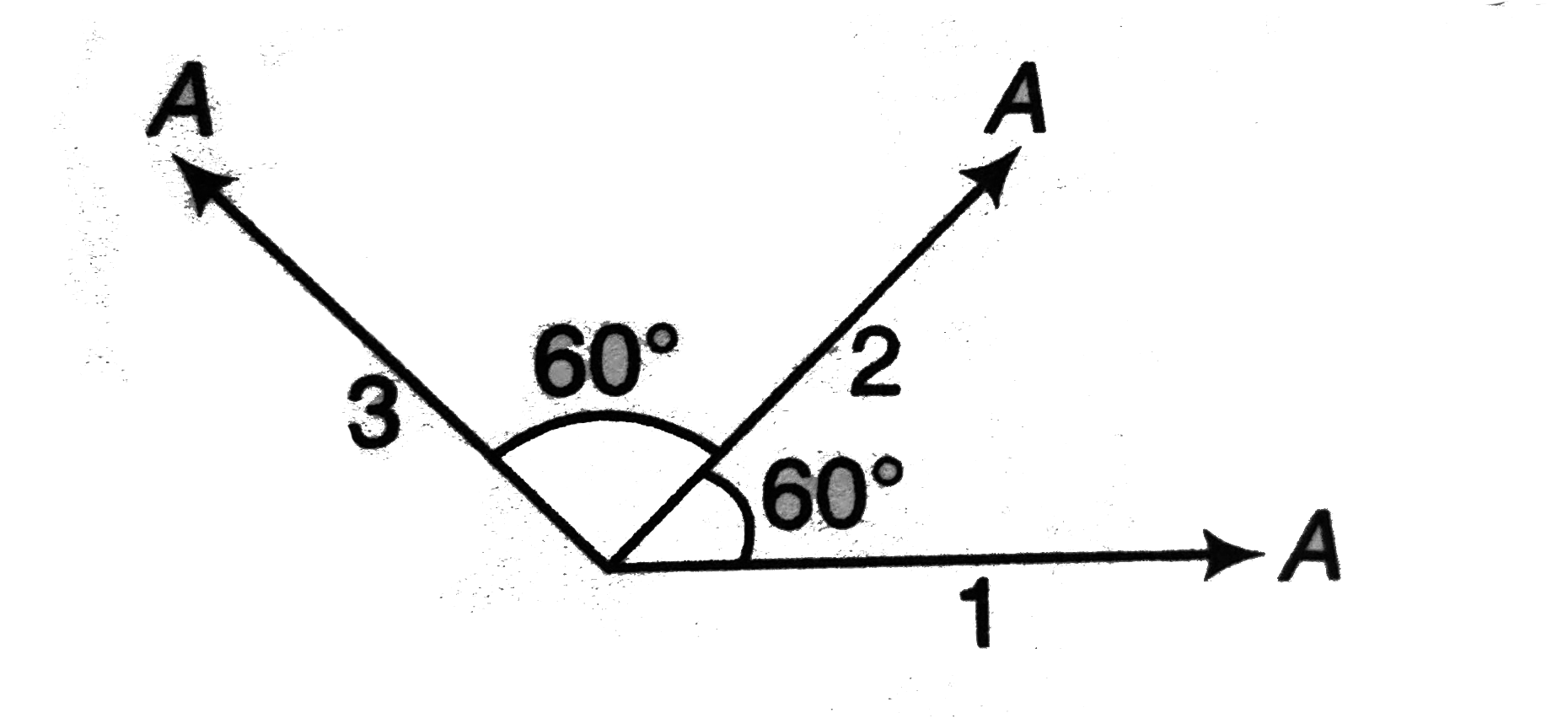Three simple harmonic motion of equal amplitudes A and equal time periods in the same direction combine. The phase of the second motion is 60∘ ahead of the first and the phase of the third motion is 60∘ ahead of the second. Find the amplitude of the resultant motion.
The correct Answer is:A, B
Resultant of 1 and 3 is also A in the direction of 2.

∴AR=2A.
Topper's Solved these Questions
- SIMPLE HARMONIC MOTIONBOOK - DC PANDEYCHAPTER - SIMPLE HARMONIC MOTIONEXERCISE - Only one question is correct
48 Videos
- SIMPLE HARMONIC MOTIONBOOK - DC PANDEYCHAPTER - SIMPLE HARMONIC MOTIONEXERCISE - JEE Advanced
34 Videos
- SIMPLE HARMONIC MOTIONBOOK - DC PANDEYCHAPTER - SIMPLE HARMONIC MOTIONEXERCISE - Exercise 14.3
7 Videos
- SEMICONDUCTORS AND ELECTRONIC DEVICESBOOK - DC PANDEYCHAPTER - SEMICONDUCTORS AND ELECTRONIC DEVICESEXERCISE - More than One Option is Correct
3 Videos
- SOLVD PAPERS 2017 NEET, AIIMS & JIPMERBOOK - DC PANDEYCHAPTER - SOLVD PAPERS 2017 NEET, AIIMS & JIPMEREXERCISE - Solved paper 2018(JIPMER)
38 Videos
Similar Questions
(a) A particle is subjected to two SHMs of same time period in the same direction. If A1=6cm, A2=8cm, find the resultant amplitude if the phase difference between the motions is (a) 0∘, (b) 60∘, (c) 90∘ and (d) 120∘.
(b) In the previous problem if A1=A2=a and resultant amplitude is also a, find phase difference between them.
(c) Three SHMs of equal amplitude A and equal time periods in the same direction combine. The phase of the second motion is 120∘ ahead of first and the phase of the third motion is 120∘ ahead of the second. Find the amplitude of the resultant motion.
View SolutionA particle is subjected to three SHM's in same direction simultaneously each having amplitude a and equal time period. The phase of the second motion is 300 ahead of the first and the phase of the third motion is 300 ahead of the second. Find the amplitude of the resultant motion.
View Solution
Knowledge Check
Time S.H.M. of equal amplitude a and equal time period in the same direction combine. The first is 60∘ ahead of the second and second is 60∘ ahead of the third S.H.M. The amplitude of the resultant oscillation is:
AaB2aC0D4aThe equation of a simple harmonic motion (amplitude 5 cm and time period 0.5 second) is
Ay = 0.5 sin 2πt,By=0.5sin(2at)5Cy=5sin4πtDy=5sinπtThree SHO's of equal amplitude A and equal time period combine in the same direction. The difference in phase between successive SHO's os 60∘ahead of the other. The amplitude of the resultant oscillation is
AAB2AC0D4A
A simple harmonic motion has an amplitude A and time period T. What is the time taken to travel from x=A to x=A/2?
View SolutionA particle is subjected to two simple harmonic motions of sae time period in the same direction. The amplitude of the first motion is 3.0 cm and that of the second is 4.0 cm. Find the resultant amplitude if the phase difference between the motion is a. 0∘,b.60∘,c.90∘
View SolutionA simple harmonic motion of amplitude A has a time period T. The acceleration of the oscillator when its displacement is half the amplitude is
View SolutionFor a particle executing simple harmonic motion, the amplitude is A and time period is T. The maximum speed will be
View SolutionThree simple harmonic motions in the same direction having the same amplitude and same period are superposed. If each differ in phase from the next by 45∘, then
View Solution
